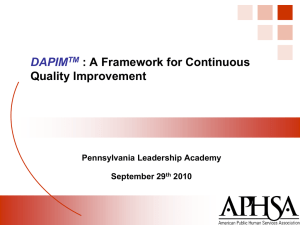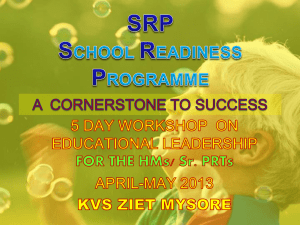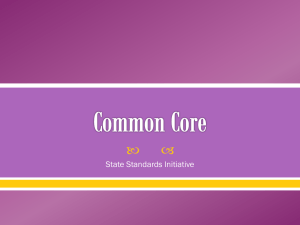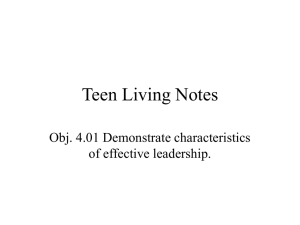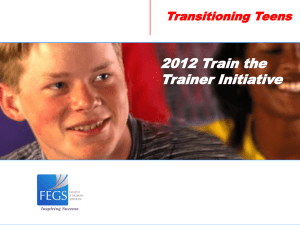Career Academies
advertisement
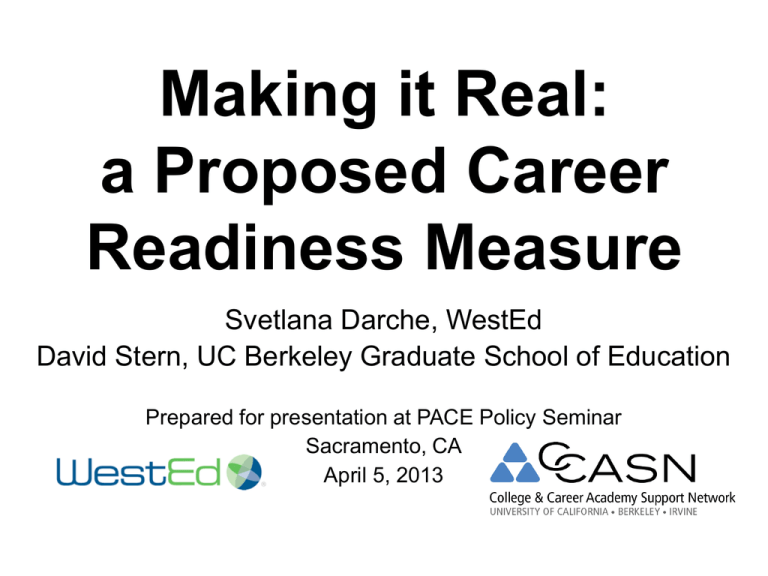
Making it Real: a Proposed Career Readiness Measure Svetlana Darche, WestEd David Stern, UC Berkeley Graduate School of Education Prepared for presentation at PACE Policy Seminar Sacramento, CA April 5, 2013 What we’ll talk about Context: SB 1458 A proposed measure of career readiness to include in new API Rationale for proposed measure Rating student performance at work Implementation issues Context: SB 1458 For high schools, up to 40% of API may consist of information other than STAR and CAHSEE scores The non-test 40% must include graduation rates “the Superintendent, with approval of the state board, may incorporate into the index for secondary schools valid, reliable, and stable measures of pupil preparedness for postsecondary education and career” (EC 52052 (a) (4) (F) (ii)) PSAA Advisory Committee framework for CCI On Feb 12 the Public Schools Accountability Act Advisory Committee considered a framework for a college and career indicator (CCI), recommended by the Technical Design Group (TDG) CCI would be a composite consisting of a number of different measures Each measure would be scored at five levels Each student’s score would be the highest score attained on any of the measures Definitional Premise “Career readiness” in our view means having the foundational skills, knowledge, and dispositions needed for long-term career success – irrespective of the postsecondary path taken to get there. CRPC Definition A career-ready person effectively navigates pathways that connect education and employment to achieve a fulfilling, financially-secure and successful career. A career is more than just a job. Career readiness has no defined endpoint. To be career ready in our everchanging global economy requires adaptability and a commitment to lifelong learning, along with mastery of key academic, technical and workplace knowledge, skills and dispositions that vary from one career to another and change over time as a person progresses along a developmental continuum. Knowledge, skills and dispositions are inter-dependent and mutually reinforcing. ~Career Readiness Partner Council Endorsement “The Common Core State Standards (Common Core) articulate what students need to know and be able to do in English language arts/literacy and mathematics for success in college and careers. The college readiness benchmarks are the same as the career readiness benchmarks in the Common Core State Standards. The Career Readiness Partner Council’s statement contributes to the national dialogue on career readiness by affirming that career readiness includes the Common Core State Standards while painting the broader picture of the range of knowledge, skills, and dispositions that students must exhibit beyond literacy and mathematics. Implementation of the Common Core State Standards will be strengthened in schools, districts, and states by looking at the Common Core in the context of the career readiness definition outlined in this paper.” ~Gene Wilhoit, Executive Director, CCSSO A proposed measure of career readiness Supervisor’s rating of a student’s performance in a paid job, paid or unpaid internship, school-based enterprise, or other qualifying experience that allows application and demonstration of important careerrelated transferable skills. Some guiding principles Simplicity – employ a measure that can apply to any student Validity – measure real career readiness, not a proxy Appropriateness of incentives – measure what we value Authenticity – measure actual performance Complementarity – add value and provide a full picture of student performance Feasibility – employ a measure that can be captured before students leave 12th grade In accordance with these principles, the rationale for our proposed measure is as follows: Rationale for proposed measure (1) A direct measure of students’ career success would be too late to be useful: A direct way to determine whether a high schools’ students are well prepared for careers would be to measure occupational success after students have graduated. However, to give an accurate picture these surveys would have to wait until graduates have reached age 30 or so, which would be too late to inform current practice. Rationale for proposed measure (2) Our proposed measure offers appropriate timing and face validity: A student’s successful performance in a job, internship, school-based enterprise, or other qualifying experience can be determined at the end of senior year, and has face validity as an indication that students have already begun to develop career-related capabilities in real productive settings. Rationale for proposed measure (3) It measures skills that are not easily developed and measured in classrooms, and that affect long-term career success: Working in a job, internship, or school-based enterprise can develop abilities and behaviors that are not usually developed in regular school classrooms (e.g., collaboration with people of different ages). There is evidence that these abilities and behaviors affect career success later in life, over and above the impact of cognitive skills and years of schooling. Rationale for proposed measure (4) Assessment of student’s performance must explicitly rate important skills and behaviors: The judgment that a student has performed satisfactorily in a job, internship, school-based enterprise or other qualifying experience must involve explicit indications of whether the student has developed these work-related abilities and behaviors. For instance, the NAF Supervisor Assessment form lists 7 foundational skills, 7 applied workplace skills, 9 skills reflecting self-management and personal responsibility, 4 indicators of knowledge of the field, as well as position-specific technical skills that are named by the supervisor. Rationale for proposed measure (5) Only high-quality work-based learning experiences would count: Including such work-related skills, abilities, and behaviors in the definition of satisfactory performance ensures that the job, internship, school-based enterprise, or other qualifying experience has provided opportunities to develop these. Rationale for proposed measure (6) This measure gives schools incentive to provide access to experiences that develop career readiness: A high-quality work-based learning experience helps students develop these abilities and behaviors that are related to long-term career success. Rewarding high schools where more seniors have performed satisfactorily in a job, internship, school-based enterprise, or other qualifying experience will encourage schools to develop these forms of work-based learning as part of the curriculum, and will thus promote development of abilities and behaviors that contribute to students’ later career success. Rationale for proposed measure (7) It measures what can be validly measured: It is better to measure students’ career-related abilities and behaviors in the context of actual work performance than by giving students a battery of tests. There is good evidence that abilities and behaviors developed by late adolescence strongly affect career success later in life, but there has not been enough research to determine exactly which of these abilities and behaviors are most important, and in which combinations. Research on predicting long-term career success Years of schooling and cognitive ability are both strong predictors of later earnings, but leave most variance unexplained In addition, various abilities and behaviors, other than knowledge of school subjects, also predict earnings Variables measured around age 20 that predict earnings decades later include: planful competence, self-esteem, locus of control, work habits, leadership skills, teamwork and other sports-related skills, discipline problems in high school, ability to function in a cohesive small group, independence, persistence, initiative, outgoing character, and emotional stability Evidence that working helps teenage development Skills and abilities develop through practice Working while in high school leads to higher earnings after high school –– and does not interfere with academic achievement if less than ~20 hrs/wk High school work experience has been found to help develop positive work values, self-confidence, sense of efficacy, planfulness, commitment, and identity formation, among other qualities Quality of work experience matters School-supervised work experience has been found to offer more opportunity than non-school supervised experiences to learn new things, work in teams, perform a variety of tasks, and take initiative Rating student performance at work B. Applied Workplace Skills Systems thinking 1 2 3 4 N/A Creativity and innovation 1 2 3 4 N/A Information technology application 1 2 3 4 N/A Teamwork/collaboration 1 2 3 4 N/A Ability to work with diverse individuals 1 2 3 4 N/A Ethical behavior 1 2 3 4 N/A Flexibility/adaptability 1 2 3 4 N/A C. Self-Management and Personal Responsibility Part II. Knowledge of the Field and Organizational Context Please rate the student’s knowledge of the industry/field, occupation, and organizational context according to the rating scale below. 1 Level of Knowledge Falls Below Expectations 2 Level of Knowledge Approaches Expectations 3 Level of Knowledge Meets 4 Level of Knowledge Exceeds Expectations Expectations N/A No Opportunity to Observe Understands career opportunities/requirements in the industry or field overall 1 2 3 4 N/A Understands career opportunities/requirements in the specific occupational area related to the internship or student project 1 2 3 4 N/A Understands the culture, etiquette, and practices of the workplace or the project client’s organization and knows how to navigate the organization 1 2 3 4 N/A Knows how to interact with supervisors, clients, and teammates 1 2 3 4 N/A For each of the ratings above in Parts I and II, evidence (examples of performance) can be provided for any rating in the online form; examples must be provided for lowest ratings (skills rated at level 1) and highest ratings (skills rated at level 4). If using the paper form to complete the assessment, please add required examples on additional pages marked to coincide with the rated dimension. Implementation issues • Fitting the PSAA framework • Reliability • Reporting Fitting the framework This measure could be one of several included in the CCI In our PACE brief “Making it Real: How High Schools Can Be Held Accountable for Developing Students’ Career Readiness” (http://www.edpolicyinca.org/publications/making-itreal-how-high-schools-can-be-held-accountabledeveloping-students-career-readiness), we proposed using percentage of seniors who had obtained a satisfactory performance rating from a work experience, but scoring a student’s performance at one of five levels is also possible Reliability of supervisor ratings In many work settings, performance appraisal is a routine procedure, and must be sufficiently reliable to withstand legal challenge Studies of inter-rater reliability of NAF supervisor assessment have been proposed, including test of whether training may improve reliability Judgments of five levels of performance may be less reliable than judgment of satisfactory vs. nonsatisfactory Reporting results to CDE Schools can report results as part of CALPADS: could be called assessment of student performance in demanding work Districts would keep records, just as they have kept records for Work Experience in the past CDE could conduct occasional spot checks



